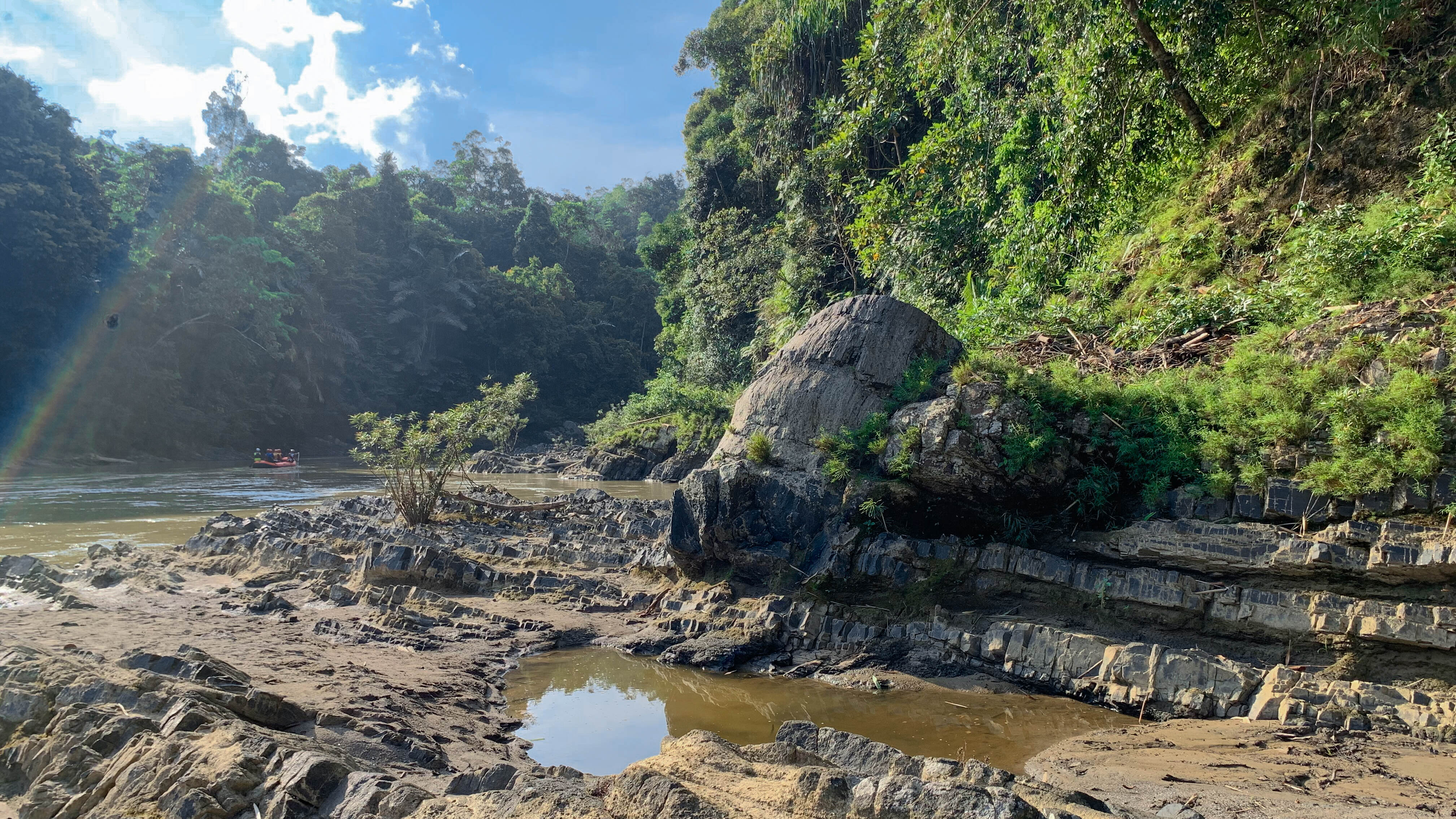
Jambi, a province located on the island of Sumatra in Indonesia, is a fascinating destination that offers a wealth of natural beauty, cultural heritage, and historical significance. With its stunning landscapes, diverse wildlife, and vibrant local communities, Jambi has something to offer to every traveler.
In this article, we will delve into 36 interesting facts about Jambi, giving you a comprehensive insight into this captivating province. From its rich history as a center of the ancient Srivijaya kingdom to its lush rainforests and majestic rivers, Jambi is a treasure trove of unique experiences waiting to be explored.
Whether you are planning a trip to Jambi or simply curious about this enchanting destination, prepare to be amazed by the wonders that this province has to offer. So, let’s embark on a journey through 36 fascinating facts that will help you discover the hidden gems of Jambi.
Key Takeaways:
- Jambi, Indonesia, is a hidden gem with lush rainforests, ancient temples, and vibrant cultural traditions. From endangered wildlife to traditional music, it’s a paradise for nature and culture lovers.
- Jambi’s rich history, diverse ethnic groups, and mouthwatering cuisine make it a captivating destination. Whether you’re into outdoor adventures or cultural experiences, Jambi has something for everyone.
Jambi is home to the enchanting Kerinci Seblat National Park.
Spanning an impressive area of 13,791 square kilometers, Kerinci Seblat National Park is a UNESCO World Heritage Site and showcases the region’s incredible biodiversity. It is home to numerous endangered species, including the critically endangered Sumatran tiger and the elusive Sumatran rhinoceros.
The iconic Mount Kerinci dominates Jambi’s skyline.
Standing tall at 3,805 meters, Mount Kerinci is the highest volcano in Indonesia and offers breathtaking panoramas for adventurous trekkers. The challenging hike to its summit rewards visitors with awe-inspiring views of the surrounding lush rainforest and picturesque valleys below.
Jambi boasts a rich historical background.
With a history dating back over 1,300 years, Jambi was once the center of the prosperous Malayu Kingdom. The remnants of this ancient kingdom can be explored at the Muaro Jambi Archaeological Park, where you can marvel at fascinating relics, including a towering Buddhist stupa.
The traditional music of Jambi, called “Talempong,” is a vibrant cultural expression.
Talempong music embodies the spirit of Jambi’s locals and is performed using several bronze gongs of differing sizes. This traditional music is often heard during festive celebrations and cultural events in the province.
Jambi is renowned for its unique woven textiles.
The province is famous for producing intricate woven fabrics known as “songket.” These beautiful textiles feature stunning motifs and patterns, handwoven by skilled artisans using traditional techniques passed down through generations.
The elusive Sumatran orangutan can be found in Jambi.
Jambi is home to one of the few remaining populations of the critically endangered Sumatran orangutan. Observing these gentle and intelligent creatures in their natural habitat is a truly unforgettable experience.
The mighty Batang Hari River flows through the heart of Jambi.
The Batang Hari River is not only a lifeline for the locals but also offers opportunities for river cruises, allowing visitors to witness the stunning landscapes and spot wildlife along its banks.
Jambi is a treasure trove of archaeological sites.
Explorers and history enthusiasts will be thrilled to uncover numerous archaeological sites scattered across Jambi. From ancient temples like Muara Takus to the intriguing mysterious sites of Kerisik and Penyengat, the province offers a glimpse into its storied past.
Jambi is a melting pot of diverse ethnic groups.
The province is home to a variety of ethnic groups, including the Malay, Batin, and Kubu people. Each community has its own unique traditions, customs, and languages, adding to the cultural tapestry of Jambi.
Tanjung Jabung is a haven for nature enthusiasts.
Tanjung Jabung, a regency within Jambi, is blessed with vast mangrove forests, pristine beaches, and vibrant marine life. It is an ideal destination for snorkeling, scuba diving, and exploring the wonders of the underwater world.
Jambi is famous for its delectable culinary delights.
Food lovers will rejoice in Jambi’s diverse culinary scene. From mouthwatering local dishes like “Dendeng Batoko,” a flavorful beef jerky, to the satisfyingly spicy “Mie Kikil Jambi,” the province offers a gastronomic adventure that will tantalize your taste buds.
Jambi hosts the Kerinci International Jazz Festival.
Music enthusiasts flock to Jambi to attend the annual Kerinci International Jazz Festival, where talented local and international artists come together to showcase their skills. This vibrant event is a testament to Jambi’s growing music scene and cultural vibrancy.
Jambi is a nature lover’s paradise.
With its lush rainforests, serene waterfalls, and stunning lakes, Jambi offers endless opportunities for outdoor adventures. Whether it’s trekking through the jungles, exploring hidden caves, or kayaking in pristine lakes, nature enthusiasts will find their bliss in Jambi.
The iconic Ratu Boko Temple is a must-visit landmark.
Ratu Boko Temple, located near Muaro Jambi, is an ancient archaeological site that showcases the grandeur of Jambi’s past civilization. This fascinating complex features well-preserved structures, including a palace and a Buddhist monastery.
Jambi is home to the traditional dance form called “Tari Zapin.”
Tari Zapin is a captivating dance form that originated in Jambi and is characterized by graceful movements, vibrant costumes, and melodious music. It is often performed during cultural festivals and celebrations, mesmerizing audiences with its beauty.
Jambi is blessed with a year-round tropical climate.
Visitors can enjoy Jambi’s warm and inviting climate throughout the year. The province experiences a tropical rainforest climate, making it the perfect destination for those seeking a tropical getaway.
Jambi has a vibrant traditional martial art called “Silat.”
Silat, a traditional martial art form deeply rooted in Jambi’s culture, showcases the province’s strength, agility, and rich heritage. Witnessing a Silat performance is a thrilling experience that highlights the artistry and physical prowess of its practitioners.
Jambi is an emerging ecotourism destination.
With its commitment to conservation, Jambi is quickly gaining recognition as an ecotourism hotspot. The province offers sustainable tourism experiences that allow visitors to connect with nature while preserving its pristine environment.
Jambi’s traditional boat called “Rakit” is an iconic symbol of culture.
The Rakit is a vessel used by Jambi’s fishermen and is symbolic of the province’s reliance on waterways for transportation and livelihood. Spotting these picturesque boats floating along the rivers is a common sight in Jambi.
Jambi is a paradise for birdwatching enthusiasts.
With its diverse ecosystems, Jambi offers a haven for birdwatchers. Spotting rare and exotic bird species, such as the colorful hornbills and the elusive kingfishers, is a treat for ornithologists and nature lovers alike.
Jambi is a land of festivals and celebrations.
Jambi’s vibrant cultural scene is evident in its numerous festivals and celebrations. From the lively Hari Raya festivities to the energetic Tabuik Parade, there is always a joyous event happening in Jambi that showcases the province’s traditions and customs.
Jambi is renowned for its traditional handicrafts.
Artisans in Jambi are known for their skill in creating beautifully crafted items, such as handwoven textiles, intricate woodcarvings, and traditional pottery. These handmade products reflect the rich artistic heritage of the province.
Jambi’s floating market is a vibrant hub of activity.
The bustling floating market in Jambi offers a vibrant showcase of local culture and commerce. Here, visitors can witness the lively trade of fresh produce and traditional handicrafts as sellers navigate the waterways on their colorful boats.
Jambi is an ideal destination for river rafting.
Jambi’s pristine rivers provide the perfect setting for thrilling river rafting adventures. Whether you’re a beginner or an experienced rafter, the province’s rapids and scenic landscapes will leave you with lasting memories.
Jambi is home to sacred sites and ancient temples.
Jambi’s spiritual heritage is evident in the presence of numerous sacred sites and ancient temples. From the impressive Muara Jambi complex to the peaceful Tinggi Hari Pagoda, these sites offer a glimpse into Jambi’s religious practices throughout history.
Jambi’s traditional medicine, called “Ulek Mayang,” has healing properties.
Ulek Mayang is a traditional herbal medicine made from various plants found in Jambi’s forests. It is believed to have medicinal properties and is often used to treat various ailments among the locals.
Jambi offers breathtaking sunset views.
Witnessing a sunset in Jambi is an experience not to be missed. Whether you’re by the beach, on a mountaintop, or overlooking a river, the province’s stunning sunsets paint the sky in vibrant hues, creating a magical atmosphere.
The Jambi Batik Village is a hub of traditional textile production.
Jambi’s Batik Village is renowned for its traditional batik production. Visitors can observe the intricate process of creating batik textiles and even join in workshops to learn this ancient art form.
Jambi is home to the ethnic Malay community.
The Malay community has a strong presence in Jambi, contributing to the province’s cultural diversity. Interacting with the friendly Malay people allows visitors to gain insights into their traditions, language, and way of life.
The vibrant Jambi Royal Dance is a feast for the eyes.
The Jambi Royal Dance is a regal and captivating performance that reflects the grandeur of Jambi’s royal history. Adorned in intricate costumes, dancers gracefully execute traditional movements, enthralling audiences with their elegance.
Jambi is a gateway to the enchanting Kerinci Valley.
Located in Jambi, the Kerinci Valley is a picturesque paradise encompassed by lush mountains and vibrant rice terraces. It is a serene haven where visitors can immerse themselves in the tranquility of nature.
Jambi’s traditional architecture showcases unique craftsmanship.
The traditional houses in Jambi display intricate wood carvings and unique architectural designs. Exploring these charming houses allows visitors to delve into the province’s architectural heritage and the skills of its craftsmen.
Jambi’s cuisine is a fusion of Malay and Minang flavors.
Jambi’s culinary scene blends the flavors of Malay and Minang cuisines, resulting in a tantalizing fusion of spicy, aromatic dishes. From the fiery rendang to the savory gulai ikan, Jambi’s local delicacies are sure to satisfy any food lover’s cravings.
Jambi offers opportunities for river ecotourism.
Exploring Jambi’s rivers through river ecotourism activities is a captivating way to witness the province’s natural beauty. River tours, kayaking, and canoeing allow visitors to immerse themselves in the serene surroundings while observing the diverse flora and fauna.
Jambi celebrates the annual “Tabuik Festival.”
The Tabuik Festival is a vibrant event held in Jambi to commemorate the martyrdom of Imam Husayn, a significant figure in the Islamic faith. The festival includes processions, traditional performances, and the symbolic burning of large effigies.
Jambi’s traditional games reflect its cultural heritage.
Jambi’s traditional games, such as Sepak Raga and Bujang Gadis, demonstrate the province’s rich cultural heritage and provide entertaining experiences for locals and visitors alike.
There you have it – 36 intriguing facts about Jambi that highlight the province’s natural wonders, captivating history, vibrant culture, and remarkable traditions. Whether you’re seeking adventure, cultural immersion, or simply a peaceful escape into nature, Jambi promises an unforgettable experience. So, pack your bags, venture to this Indonesian gem, and embark on a journey that will leave you with lifelong memories!
Conclusion
In conclusion, Jambi is a fascinating city with a rich history, vibrant culture, and breathtaking natural beauty. From its ancient temples and historical sites to its lush rainforests and serene lakes, Jambi offers a variety of experiences for travelers to enjoy. Whether you are interested in exploring the city’s cultural heritage, embarking on an adventurous jungle trek, or simply relaxing amidst nature’s tranquility, Jambi has something to offer everyone. So, if you’re planning your next travel adventure, make sure to add Jambi to your list of must-visit destinations. Discover the wonders of this hidden gem in Indonesia and create memories that will last a lifetime.
Now that you have learned numerous facts about Jambi, you are well-equipped to explore this captivating city. So, pack your bags, prepare for an incredible journey, and get ready to immerse yourself in the wonders of Jambi!
FAQs
1. What is the best time to visit Jambi?
The best time to visit Jambi is during the dry season, which typically falls between April and September. During this time, the weather is generally pleasant, with lower chances of rainfall and more suitable conditions for outdoor activities.
2. How do I get to Jambi?
Jambi is accessible by both air and land. The city has an airport, Sultan Thaha Syaifuddin Airport, which is served by domestic flights from major cities in Indonesia. Alternatively, you can also reach Jambi by bus or car, with well-connected road networks from neighboring cities and provinces.
3. What are some popular attractions in Jambi?
Jambi offers a range of attractions to explore, such as the UNESCO World Heritage site of Muaro Jambi Temple Complex, the serene Lake Kerinci, the stunning Harau Valley, and the vibrant Pasar Angso Duo traditional market. These are just a few of the many remarkable sites that showcase the beauty and culture of Jambi.
4. Are there any local delicacies in Jambi?
Absolutely! Jambi is known for its unique culinary delights. Some popular local dishes include pindang patin (spicy catfish soup), gulai kambing (spiced goat curry), and pempek (fishcake served with a tangy sauce). Don’t forget to try these mouthwatering delicacies during your visit to Jambi.
5. Can I experience eco-tourism in Jambi?
Definitely! Jambi is a haven for eco-tourism enthusiasts. You can explore the pristine natural landscapes of Kerinci Seblat National Park, go hiking in the Bukit Tiga Puluh National Park, or take a boat trip along the Batanghari River to witness the beauty of Jambi’s flora and fauna.
6. Is Jambi a safe city for tourists?
Yes, Jambi is generally considered a safe city for tourists. However, it’s always advisable to take common safety precautions such as avoiding isolated areas at night, keeping your belongings secure, and being aware of your surroundings.
7. What cultural festivals or events can I experience in Jambi?
Jambi boasts a rich cultural heritage, and there are various festivals and events held throughout the year. One notable festival is the Tabot Festival, which commemorates the martyrdom of Imam Hussein. During this festival, colorful processions and traditional performances can be witnessed in the streets of Jambi.
8. Can I find accommodations easily in Jambi?
Yes, Jambi offers a range of accommodations to suit different budgets and preferences. From luxury resorts and hotels to guesthouses and homestays, you can easily find a place to stay in Jambi. It’s always recommended to book in advance, especially during peak travel seasons.
9. Are there any unique souvenirs I can buy in Jambi?
Absolutely! Jambi is known for its traditional crafts and products. Some popular souvenirs include traditional woven fabrics (songket), intricate wood carvings, and batik textiles. These make for perfect keepsakes to bring back home and cherish the memories of your time in Jambi.
10. Can I explore Jambi on my own, or should I hire a guide?
While it is possible to explore Jambi on your own, hiring a guide can enhance your experience by providing local insights, historical knowledge, and ensuring your safety. A guide can also help you navigate the language barrier and connect with the local culture more deeply.
Jambi's captivating facts leave you yearning for more. Satisfy your curiosity by exploring the awe-inspiring Jambi Stadium, where sports and architecture intertwine. Unravel the mysteries of Muaro Jambi Temples, ancient relics that whisper tales of a bygone era. Embark on a journey through Jambi's rich tapestry of history, culture, and natural wonders, and let these fascinating insights be your guide.
Was this page helpful?
Our commitment to delivering trustworthy and engaging content is at the heart of what we do. Each fact on our site is contributed by real users like you, bringing a wealth of diverse insights and information. To ensure the highest standards of accuracy and reliability, our dedicated editors meticulously review each submission. This process guarantees that the facts we share are not only fascinating but also credible. Trust in our commitment to quality and authenticity as you explore and learn with us.


